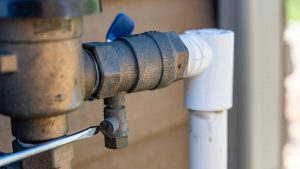Backflow prevention is crucial for protecting water supplies and maintaining a water system. However, before you learn what backflow prevention is, what is backflow in the first place? And what causes it? We explore these questions below, breaking down backflow testing, prevention, and common causes of the issue.
Read on to learn more about different plumbing issues and preventative measures that will help minimise future calls to your local plumber!
What is backflow & why is it harmful?
Backflow occurs primarily in agricultural, industrial, and hospitality environments. Water, waste, or effluent is siphoned from your facility and back into the public supply. Typically, it’s negative pressure or a pressure imbalance that causes this to occur. Back pressure is another potential cause, which can occur when fire protection systems or multi-story buildings have higher water pressure. Other issues, such as long-lasting power outages or a broken water main nearby, can also be possible culprits.
When this occurs, the quality and integrity of the public supply are compromised, so backflow prevention is mandatory.
Common causes of backflow around the house
Backflow can occur due to negative pressure from several possible causes. For example, while water distribution systems are designed to send water flowing in a particular direction (from the system to the consumer), the water can move in the wrong direction if hydraulic conditions deviate from ‘normal’.
For example, backflow can occur when the tank or water trough pressure is less than the water system’s pressure. This may cause the inflow or pull of contaminated water back into the system. Back pressure is another potential cause of backflow and can happen when fire protection systems or multi-story buildings have higher water pressure.
Other issues, such as long power outages or a nearby broken water main, can also be the culprit. But we can also cause backflows through simple mistakes when dealing with water around the house.
Imagine you’re out watering the garden and the phone rings. You pop the hose in a nearby—half-full—bucket and run inside to answer the call. You hang up the phone and carry on with your day, forgetting about the hose and garden entirely.
This mistake could lead to detrimental consequences. The garden hose is the most common cause of back siphonage in residential properties. When left running while submerged in a pool or bucket, the pressure can take water back to the main water supply. The same thing can occur when shower heads are left submerged while running.
So, when dealing with appliances that release water, be mindful of where you leave them. The next thing you can do for ultimate prevention is to work with the best plumbing services available for backflow prevention testing.
What is backflow prevention?
So now you know what backflow is and why it occurs; what is backflow prevention? A legal requirement for homeowners in New Zealand, backflow prevention is vital for all home plumbing systems.
Why backflow prevention & testing is important
Backflow prevention devices eliminate backflow by only allowing a one-way flow through the pipes. Backflow prevention devices are complex and technical. They feature test cocks, shut-off valves, and sometimes vacuum breakers and other built-in components. They contain many moving parts. For this reason, backflow prevention devices must be inspected and certified annually.
Although most family homes don’t experience backflow or require sophisticated prevention devices, all new build homes and renovations must have vacuum breaker devices in outdoor taps. These devices prevent backflow from pools, buckets and the like. Additionally, certain fittings, such as bidets, present a slight backflow risk and require an inline backflow valve to be fitted.
In many cases, a little backflow won’t do much damage. You may notice something is ‘off’, but it shouldn’t pose a health concern if it is low risk. In contrast, high-risk situations pose a much greater threat to health and safety.
Keep an eye on your plumbing and water appliances. If there’s a strange smell, lower pressure than usual, or an odd taste and colour in your drinking water, get in touch with an experienced professional. Trained plumbers will evaluate the risk level and determine the best course of action.
Let Auckland Plumbers Group sort your backflow testing and prevention
The team at Auckland Plumbers Group are the experts in all things plumbing. If you require backflow testing, we can sort it out! Our trained and experienced plumbers have the tools and knowledge to get your pipes back up and running. Get in touch with our team to learn how we can help with backflow prevention and arrange for your annual inspection.

